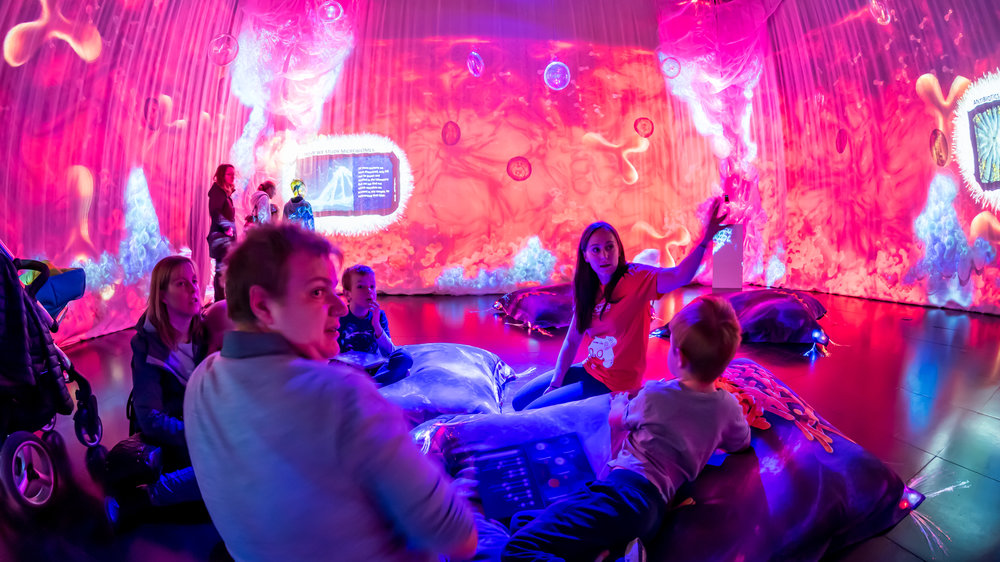Gut Feelings
Our Art-Sci installation explores the human gut microbiome and how it contributes to our health.
The Gut Feelings Installation
Gut feelings was created in collaboration with Paul Miller, who used projection mapping on to 3 walls. Rachael Rae over-laid the projections with physical structures made from translucent materials and recycled key kegs. Together, these elements depict the magical microbial world inside of our gastro-intestinal tract.
We wanted the environment to be fully interactive. So you can walk into the gut and use the touch pad interfaces to release plumes of bacteria and viruses into the scene. You can visit the information touch pads and read about how researchers study the diverse microorganisms that contribute to your gut health.
Gut feelings has been adapted for smaller settings, using single wall projections and green-screen interactions.
Please get in touch by email for a quote if you are interested in gut feelings coming to you.

Learning Through Co-Creation
We found the collaborative process of co-creation to be an interesting learning journey (link to video interview). Whist we wanted to feature hundreds of different bacterial species that contribute to human gut health, the ARTISTS helped us to see that we needed a simple message. Our team enjoyed discussing all the possibilities, but in the end we came up with a short-list of three key bacteria to represent the human gut microbiota.
3 common gut bacteria that are important for human health:
- Bifidobacterium longum is an early and dominant coloniser of the infant gut. This type of bacteria makes up >90% of our infant gut bacteria, dropping to 3% when we become adults. These bacteria synthesise vitamin B1 (Thiamine), which is commonly used in probiotics aiming to restore gut health.
- Ruminococcus bromii is known as a “keystone species”. It breaks down dietary fibre and starch resulting in the release of energy and other products that can be used by other important bacteria in the gut.
- The Bacteroidete group of bacteria make up the dominant portion of our gut microbiota and help us to digest food. Different types can dominate depending on diet and geography. Bacteroides fragilis is more commonly found in the colon of people with lower fibre, high fat diets in Europe and North America. Prevotella copri is more commonly found in the colon of people with a higher fibre diet in Africa and South America.
What about the viruses?
We also included bacteriophages (bacterial viruses), which out-number bacteria by at least 10:1 in most environments. They are critical drivers of bacterial evolution and affect bacterial behaviour in many ways. As antimicrobial resistance continues to increase, there is renewed interest in bacteriophages as alternative therapeutics to treat bacterial infections. However, relatively little is known about them amongst public audiences.
How do antibiotics affect the healthy microbiota?
We wanted to get people talking about the inappropriate use of antibiotics. So we worked with Paul to simulate what happens to our healthy bacteria when we take a dose of broad spectrum antibiotics. This was depicted by a disintegration of the projections on one wall, which turned dark and barren, followed by incoming pathogenic bacteria that were resistant to the antibiotics and could colonise and cause disease.